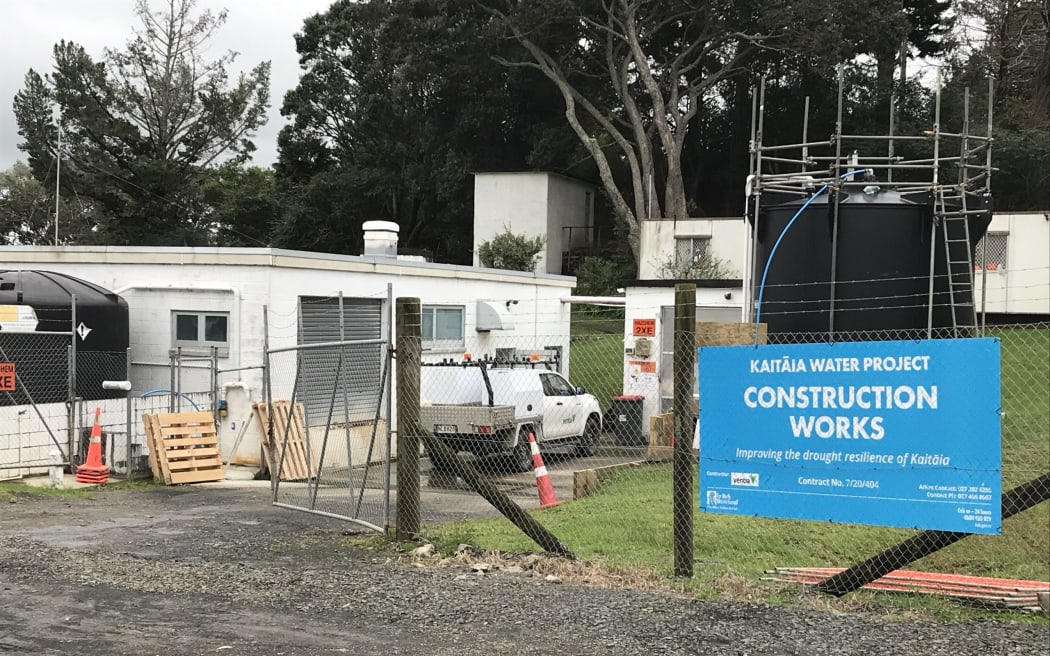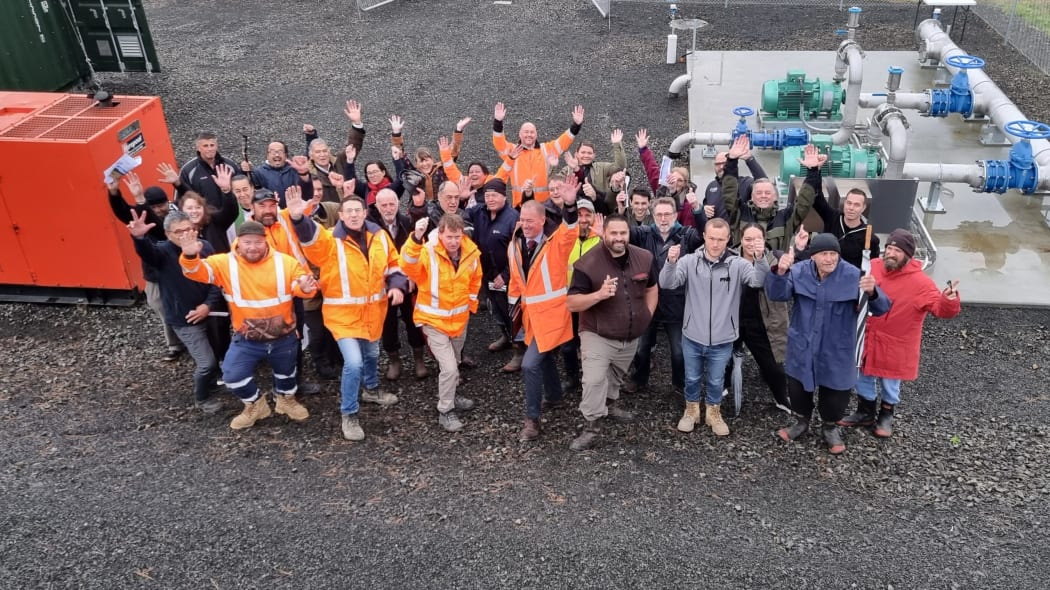Water restrictions are expected to be a thing of the past with the start-up of Kaitāia’s major new $15.3 million Sweetwater supply.

The Kaitāia water project official blessing crew at the Sweetwater pumping plant this morning
Photo: LDR / Due North PR
Far North Deputy Mayor Ann Court said the new supply would bring an end to Kaitāia’s regularly experienced water shortages which had at one point seen the Army trucking the resource into town for people to drink.
Court, Mayor John Carter, iwi leaders and more attended a Far North District Council (FNDC) official opening and dawn blessing of the new supply’s supporting infrastructure at Sweetwater today, north-west of the Far North’s biggest town and a stone’s throw from Ninety Mile Beach.
Kaitāia residents are expected to next month be drinking water from the new Sweetwater source, where pumps bring the resource from the underground Aupōuri aquifer.
Carter said bringing a supplementary supply of the resource on stream with the Kaitāia water project – Sweetwater bore and pipeline pumping station was a major plus. Awanui River would continue to be the town’s main drinking water source. Sweetwater wai would supplement this in the dry season.

Sweetwater official ribbon cutting team – from left – Trudy Allen (Ngāti Kahu), Ann Court Far North Deputy Mayor, John Paitai (Te Rarawa) and Far North Mayor John Carter
Photo: LDR / Susan Botting
The new Sweetwater plant includes a pumping station and on-site holding tanks amid rolling hills. It can provide an average of 5000 cubic metres of Aupoūri aquifer water daily for locals to drink and use.
That is more than three times Kaitāia’s existing typical average daily use of 1500 cubic metres, future-proofing the town.
The Kaitāia water project – Sweetwater bore and pipeline will build at least 100 days of extra water resilience into the Kaitāia supply for more than 5,000 local households and businesses.
Carter said the Sweetwater wai was already reaching the Kaitāia water treatment plant in Okahu Road.

Archdeacon Fran Hokianga (Te Patu, Ngāti Kahu, Ngāi Takoto) blessed the Sweetwater site
Photo: LDR / Susan Botting
A month’s technical work would now follow to fine-tune the processes for blending the Aupōuri aquifer and Awanui River water to in turn make available to consumers by the end of July.
“It’s like creating a fine wine, it takes time for all the characteristics to integrate,” David Clamp, FNDC manager major and recovery projects said.
Clamp said the new supply would bring sustainability and help attract further growth.
The project has been funded by $12.3m from ratepayers and $3m from the Department of Internal Affairs.

Water in a box, a tank, pipes and potentially glasses – Sweetwater for all.
Photo: LDR / Susan Botting
Te Rarawa kaumātua John Paitai said the project enabled he puna wai mauri to flow out from Sweetwater to the community .
Archdeacon Fran Hokianga (Te Patu, Ngāti Kahu, Ngāi Takoto) blessed the site.
The new Sweetwater pumping facility is Northland’s newest reticulated drinking water infrastructure. It is likely to become part of council Three Waters assets moved into the new giant inter-regional top-of-New Zealand water services organisation known as Entity A – if government restructuring plans for the sector go ahead. The change will see Northland councils’ inter-generationally ratepayer-funded drinking water, wastewater and stormwater infrastructure – from FNDC, Kaipara District Council, Whangārei District Council and Auckland Council – combined into the new entity which governs and manages it.
Paparore farmer Dennis Panther said the project to get the Aupōuri aquifer water above ground and into the town’s water treatment plant had been a long time coming, first started in an earlier iteration in 2008.
Four hundred metres of the 14 kilometre pipeline taking the artesian water to Kaitāia’s water treatment plant runs through his runoff, which is immediately adjacent to the Sweetwater pumping station block.

Kaitāia water treatment plant which will soon be mixing Awanui River and Aupōuri aquifer water for reticulated water supply users
Photo: LDR / Susan Botting
The Sweetwater wai crosses four entities’ land, also traversing that of Bruce Brereton, Joe and Fiona King and Te Rarawa land.
Sweetwater was named for the long-known “good, clear, sweet water” it supplies.
Kaitāia Business Association chairperson Andrea Panther said the additional water resilience offered by the Sweetwater supply addition was positive.
She said Kaitāia’s water resilience had been among Northland’s worst.
Panther said the town’s ongoing water restrictions, drought or no drought, had a major affect on businesses.
“Car valets, florists, hairdressers – all sorts of businesses rely on water,” Panther said.
“People tend to underestimate the impact of that.”
She said it would be good for people to be able to once again use the normal amount of water needed for their business. It would not be about people suddenly using too much water, once ongoing restrictions became a thing of the past.
Panther said she hoped Kaitāia’s water would taste no different with the inclusion of the new groundwater.

Sweetwater wai will soon be flowing through pipes across these two farmers’ properties to reach the Kaitāia water treatment plant. Bruce Brereton (left) and Dennis Piper at the official opening for the new Kaitāia water resilience project.
Photo: LDR / Susan Botting
About 100 people have worked on the year-long Sweetwater project to bring long-held resilience to life.
Court said the year-long project had been completed on time and within budget.
FNDC chief executive Blair King thanked Te Rarawa, Ngāi Takoto and Ngāti Kahu iwi for their involvement with the project.
Clamp said the new Awanui/Aupōuri drinking water mix would taste no different.
The Sweetwater project includes two production bores to ensure adequate supply and to allow for maintenance, a pipeline to the water treatment plant at Okahu Road and a connection into the water treatment plant. The bore site includeS buffer tanks and a booster pump to convey water from the buffer tanks to the water treatment plant, along with power and telemetry.
Local Democracy Reporting is Public Interest Journalism funded through NZ on Air




